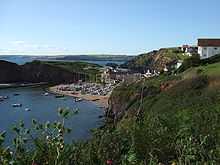Hope Cove

Hope Cove is a small seaside village within the civil parish of South Huish in South Hams District, Devon, England. It is located some 5 miles west of Salcombe and 5 miles south-west of Kingsbridge. It has two beaches, and is sheltered by the headland of Bolt Tail.
Historically, the village falls into two parts — Outer Hope and Inner Hope. Inner Hope fell within the parish of Malborough until the 1970s, when it was united with its neighbor on the other side of a small headland. Both parts of the village originally developed as centres for the local fishing industry. Hope also developed a reputation for smuggling and for plundering wrecked ships.[1]
In 1588, the ships of the Spanish Armada passed the village as they moved up the English Channel. After the Armada was defeated and headed back through storms, the San Pedro el Mayor, a transport ship fitted out as a hospital, was blown onto the rocks between Inner and Outer Hope. The 140 survivors were initially sentenced to death, but were eventually ransomed and sent back to Spain.[2]
The Royal National Lifeboat Institution stationed a lifeboat at Hope Cove in 1878. The land for the boat house was donated by the Earl of Devon. Replacement boats were supplied in 1887, 1900 and 1903. All four boats were called the Alexandra. The station was closed in April 1930 by which time the neighbouring station at Salcombe had been equipped with a motor lifeboat which could cover Bigbury Bay.[3]
Since 1992 a rescue boat has been based in Inner Hope and was manned by volunteer Coastguards under the management of the Maritime and Coastguard Agency (MCA) as part of the Cliff Rescue Team (CRT). The decision was made in 2010 that the MCA would no longer maintain any rescue boats in the UK. The Under Secretary for Transport recognised the ongoing need for this sea rescue facility in Bigbury Bay and gave the village the opportunity to run an Independent Life Boat. A public meeting was held in the village and unanimous support given to form a limited company and registered charity to achieve this. The village is now the owner of the 63rd Independent Life Boat in the UK and will work with the MCA and the RNLI to continue to meet their goal of Protecting and Preserving Life in Bigbury Bay. The operational area will run from Soar Mill Cove in the East to the mouth of the River Erme in the West and range 2 miles out to sea. It will also assist the RNLI boats from Salcombe and Plymouth outside of this area if requested. The website for the Hope Cove Life Boat is www.hopecovelifeboat.org and contains more information about the charity etc.
The village is now mainly devoted to tourism and was the setting for the 1985 cult British movie The Supergrass. The area lies within the South Devon Area of Outstanding Natural Beauty.[4]
References
- ↑ Hope Cove in Devon - Devon Online
- ↑ South Devon AONB | Heritage, Landscape & Wildlife: Hope Cove to Bolberry Down
- ↑ Leach, Nicholas (2009). Devon's Lifeboat Heritage. Chacewater: Twelveheads Press. p. 28. ISBN 978-0-906294-72-7.
- ↑ South Devon AONB | Home
External links
![]() Media related to Hope Cove at Wikimedia Commons
Media related to Hope Cove at Wikimedia Commons
Coordinates: 50°15′N 3°52′W / 50.250°N 3.867°W